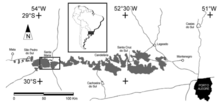Caturrita-Formation
The Caturrita Formation is a lithostratigraphic rock formation of sedimentary origin from the Upper Triassic of southern Brazil. It belongs to the Santa Maria Super sequence (upper portion ) from the Rosário -do- Sul Group and was deposited in the Paraná Basin.
Etymology
The name of the rock formation is derived from Caturrita, a barrio (neighborhood ) of Santa Maria in the Brazilian state of Rio Grande do Sul. With Caturrita also is called in Portuguese, the monk parakeet ( Myiopsitta monachus).
Stratigraphy
The sediments of the Caturrita formation belong to the second unit of the Santa Maria Super sequence superimposed on the Alemoa Members of the Santa Maria Formation, with a gradual facies transition between the clayey sediments of Alemoa - Members to the more sandy sediments of the Caturrita lineup takes place. The Caturrita lineup ends with an erosive unconformity, they do overlap then the Rhaetian sediments of the Mata Sandstone, the third unit of the Santa Maria Super sequence.
Previously, the Caturrita lineup was still regarded as a member of the stratigraphically higher lying Botucatu formation or expanded in their temporal extension to the slope ends so that they the Mata Sandstone with included.
The Caturrita formation reaches a maximum thickness of about 60 meters, but is usually mostly by only 30 meters.
Age
There are yet no absolute age information available, the Caturrita lineup, however, attributed due to fossil finds an Upper Carnia to Noric age, corresponding roughly to the period 220 bis 215 million years BP.
Distribution area
The Caturrita formation is disrupted in the southern Brazilian state of Rio Grande do Sul. She dresses in a thin band in the central part of the state over a distance of approximately 250 kilometers in east-west direction from the city Taquari up to Mata.
Deposition conditions
The sediments of the Caturrita Formation form the upper portion of the second unit of the Santa Maria Super sequence. Sequenzstratigraphisch they are at a sea level high stand ( engl. " high stand systems tract ") equivalent. It is a gradual facies transition from the scarlet, predominantly clayey, ephemeral, fluviolakustrinen deposits of Alemoa - Members ( river meanders and oxbow lakes with alternating feinschichtigen clay, silt and sandstone layers ) towards a year-round active braided river system with emphasis on the sandy component. Accompanied at the same time a change to wetter climatic conditions.
The Caturrita lineup consists of the deposited under continental conditions alluvial Schwemmsedimenten that are typically formed as massive sandstones and siltstones.
Fossil content
The Caturrita lineup houses an important biostratigraphic routing zone for tetrapods, the so-called " Ictidosauria Assemblage Zone » Ca -1. Ictidosauria are trithelodontide Cynodontia, precursor or sister group of mammals. Recently, this routing zone is referred to as " Mammaliamorpha Cenozone " in order to highlight the importance of Cynodontierfunde. The Caturrita lineup also includes the " Jachaleria » - marker horizon, named after the Dicynodontia Jachaleria candelariensis. There are also entered dinosaurs and other vertebrates days.
Noteworthy are the findings of prosauropods track in 1998 at Faxinal do soturno, a major source in the Caturrita lineup, possibly caused by Unaysaurus tolentinoi.
The fossils are concentrated around three sites:
- North of Santa Maria ( Agua Negra )
- Faxinal do soturno
- Around Candelária ( Linha São Luis )
Specifically, the following taxa were among vertebrates so far discovered in the Caturrita lineup:
- Cynodontia Brasilitherium riograndensis
- Brasilodon quadrangularis
- Diarthrognathus or Pachygenelus -like taxon
- Exaeretodon
- Irajatherium hernandezi
- Riograndia guaibensis
- Ischigualastia
- Jachaleria candelariensis
- Guaibasaurus candelariensis
- Sacisaurus agudoensis? questionable dinosaur
- Saturnalia Tupiniquim
- Spondylosoma absconditum? questionable dinosaur
- Teyuwasu barbarenai
- Unaysaurus tolentinoi
- Staurikosaurus pricei
- Indeterminate taxon
- Soturnia caliodon
- Proterochampsa
- Clevosaurus brasiliensis








